PPC
Maximizing eCommerce and Performance Marketing Activity

The pandemic and resulting consumer behavior changes have led to a new era of eCommerce, with people around the world increasing their reliance on online shopping and brands investing far more money and attention in direct-to-consumer activity. It’s thought that 78% of D2C brands have increased their marketing budget over the past few years compared to only 60% of traditional retailers.
With so many businesses turning to eCommerce to drive overall business growth, there is far more focus on the end-to-end customer experience, CRM, and broader data usage to help maximize the value of paid traffic. Here are a few of the key areas you can focus on to help drive success;
eCommerce
Building a Unique and Engaging Brand Experience
With so many new brands and so much competition, traditional brands are now looking to build better experiences, with incoming paid traffic being a big consideration for net new customers. Key aspects for new users coming from paid channels include more considered landing pages (with more story-telling and engaging branded content – there are some good examples here) and initial user journeys (curating products better and allowing for more engaged users, etc,).
Often there’s a need to educate users, leading with content, particularly if traffic has been driven through upper funnel paid channels. Experiences should be built around audiences with a focus on engaging content and unique user experiences. Think about how you’re telling a story and selling the brand to users from different campaigns and try to make your site unique, interactive, and deliver engaging content. A great example of this is Asket, which sends paid traffic to more curated landing pages (as per this example) and also does a great job of telling the product and brand story on their product detail pages.
This is just one example, but brands like AllBirds and On-Running are also really good at this. More traditional brands need to catch up to the DTC brands here. Lots of our clients are now investing in this area.
Better Post Purchase Experiences
With new DTC brands emerging every day, driving repeat purchases is key to allowing for higher CAC and scalability. Key considerations here include up-sells through a strong check-out experience, post-purchase considerations, and creating a strong loyalty offering to drive second and third purchases. It’s essential to think about all the touchpoints, and how to use customer data wisely once it is acquired.
For example;
Optimizing the Initial Landing Experience for New Users
It’s important to have different landing pages for different groups of users and campaigns which reflect different objectives and brand positionings. Consider things such as data capture prompts for paid users (based on new users), quick links for easy navigation (to considered pages that will aid the journey), and capitalize upon the opportunity to personalize the user experience.
For example, for a user who was driven to the site via Google Shopping, showing more prominent cross-sells or highlighting a price match CTA is likely to hold more weight than a user who came direct (these users are often more price sensitive so it’s important to try and maximize these kinds of things).
The importance of A/B testing really comes into play here to better understand how to maximize the traffic
Paid Media
Utilizing and Obtaining More First-Party Data
One of the bigger shifts in the market is changes with regard to privacy and stricter regulations coming into play. Last year’s changes around iOS 14 and Google moving to a cookie-less world pose new and continued challenges to advertisers.
Across paid channels, adopting your 1st party data will help drive greater success. Creating segmentation such as VIP or At Risk will allow you to target more relevant content. Capturing that data is also increasingly more difficult, in addition to pop-ups on site as mentioned above, it’s good to consider value exchange and rewarding data sharing, particularly on social channels, enticing new customers to share details or encourage re-engagement.
We are increasingly seeing brands become more creative with the way in which they do this, with things such as engaging quizzes to aid product fit, etc. The data from this can be fed into a customer property within your CRM.
Continue to Add Value in a World of Automation
It seems over the past 18 months, Google Ads has had a complete overhaul. Now with Performance Max adoption soon to become mandatory, focus on continuing to add additional value. Consider how you can maintain a level of control over the catalog and display ads within campaigns, and how the users will experience the brand once they land on site. Supply the campaigns with a strong set of assets, and build out and test relative asset groups to better understand what resonates best with the user. There may be some key learnings you can take here, with regard to site merchandising. Finally, think about how you can incorporate business data, best sellers’ insights, or margins for greater efficiency.
Enhancing your Activity
One of the biggest trends we’ve seen across our clients of late is the diversification of channel mix and reaching further upper funnel audiences. The likes of TikTok, Snap, and Pinterest have been of particular focus. However, one of the bigger challenges is justifying the role these channels have to play to key stakeholders when typically ROAS is lower here. CoS has been a key metric that has allowed us to do so.
Using CoS allows us to understand the wider impact of paid marketing on-site revenue. Scaling spending whilst keeping CoS flat is the overall goal – but when spending more and assessing your CoS and overall revenue you can begin to understand the impact of additional or less spend on-site revenue.
We’d still recommend measuring and optimizing towards platform ROAS to ensure campaign activity is as effective as possible. However, this allows you to understand the diminishing returns of paid activity and to forecast more accurately how your paid activity can contribute to eCommerce results as you invest more.
Another key factor is that a lot of brands will monitor platform ROAS on a small lookback window (7 days on Facebook for example). Whereas a number of brands will have a much longer path to purchase and using CoS allows you to account for media spend and revenue over a much longer period
Final Thoughts
Consumers expect online experiences to be smooth and friction-free, and with an ever-competitive marketplace, it’s important brands put the time in to ensure they stand out and speak to their audience.
Creating quality content both on-site and across paid channels is a great way to drive traffic. It’s also critical to identify the ways in which you can keep your audience engaged, driving greater data capture and increasing brand loyalty. And finally, ensure you are always testing across your site and media mix, helping drive insight into actionable next steps for greater success.
PPC
4 New Google Ads Performance Max Updates: What You Need to Know

Ever since the launch of Performance Max (also sometimes called PMax) campaigns in 2021, Google has continuously doubled and tripled down on the new campaign type. Originally, most tools were focused on making it easy to “upgrade” your existing campaigns to PMax, whether it be Shopping, Dynamic Search Ads, or Display.
In recent months, there have continued to be countless updates to the Performance Max campaign ecosystem, but in my mind, they almost exclusively focus on two main areas: creative assets and targeting controls. In this post, I want to walk you through a few of the updates (although certainly not an exhaustive list) that have come out recently and what these trends mean overall for your Performance Max campaigns.
Contents
Updates to Performance Max creative assets
We all know our creatives are the first impression (sometimes literally) our brands can have on our customers. With Performance Max campaigns running across all Google-owned properties, there’s a very wide range of possibilities of what your ads could look like depending on what you provide. It’s becoming more clear that Google is not going to settle for subpar creatives. Here are a couple of updates (announced in the same post) they’ve rolled out recently that lean into this idea.
🚨 Get an instant read on your Google Ads Performance Max campaigns with our free Google Ads Grader!
1. Ad strength now impacted by creative count and diversity
From the beginning with Performance Max ads, you were able to provide multiple different images, videos, and other text assets to support your creatives. The performance you saw would rely a good amount on how good those assets were.

But in early 2024, as you can see above, Google announced that now the number and diversity of those assets will have an impact on your ad strength. While I don’t believe you should use ad strength as a KPI for your company, you need to pay attention to it since these are the factors Google now finds important.
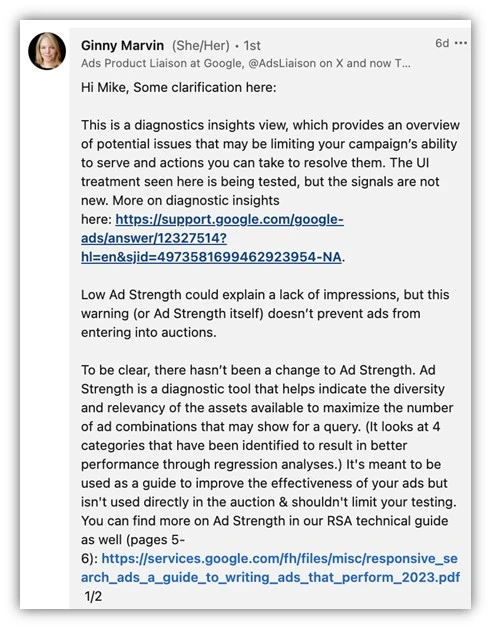

It’s also incredibly important for me to note that this does not impact the competitiveness of your Performance Max Asset Groups. The goal of these changes is to improve the diagnostics tool view for Google and help you optimize your ads. Ginny Marvin, Google Ads Liaison, clarified by saying that the components of ad strength had not changed and that low ad strength could be a reason why you’re not getting impressions but won’t prevent you from entering the auction.
If you’re up against another advertiser in the auction though (if I’m understanding correctly), all other things being equal, they may win that auction over you if they have a better ad strength with better diversity of their creatives than you do. So if you were relying on a barebones creative strategy up until now, it might be in your best interest to invest more in that space now and start to stand out from the competition and get your ad strength up.
If you’re interested in knowing all the asset formats you can use for Performance Max campaigns, here’s the best resource from Google I’ve found that outlines what you can use for your assets and the specs surrounding each.
2. New asset creation options are coming to help
Google’s not leaving anyone out of this update. It’s well known that creatives are one of the biggest hurdles for many brands, so with the announcement around ad strength, they also announced a few new updates that are here (or will be coming) to Performance Max asset creation. These tools will help with better text and image assets so you don’t have to rely on your creative teams as much as before.


First, there’s Gemini, Google’s largest and most capable AI model to support text generation for long headlines and sitelinks.


Second, Imagen 2, Google’s most advanced text-to-image technology will be used to help advertisers create lifestyle imagery using just a few simple prompts.
Both of these tools will make it incredibly easy for advertisers to extend the number of assets used in Performance Max without needing to ping a designer. Plus, the tools will still provide the ability to review all assets before they’re turned live to ensure brand safety and suitability.
Lastly, Google’s making it easier to incorporate outside sources into the creative asset mix. They’re growing their partnership with Canva with an integration app that will allow you to publish assets from Canva directly to your Performance Max assets. Additionally, they plan to roll out a preview option for anyone on your team, regardless of Google account status, so they can review creatives and collaborate.
All of these updates together make it very clear that Google’s is prioritizing the user experience and they want to make sure all advertisers have their best creative foot forward.
💡 For more ideas to improve your Google Ads strategy, check out our free guide on hacking Google Ads!
Performance Max targeting updates
When Performance Max campaigns were originally rolled out, all targeting was built in. Google Ads Performance Max targeting was basically a black box. We knew the ads would run on all Google-owned properties, but any further insight than that was pretty much non-existent, let alone any options to control what those targets would be. But in recent months, Google has softened that stance and is now providing more insights and controls on where your ads show. Not all of these updates are from the most recent announcements, but they’re all important for advertisers to know about so you can get the best performance from your PMax campaigns.
3. Brand exclusion lists
A huge problem with the Search component of Performance Max campaigns is that it would regularly spend a large portion of its budget on brand terms. This could cause problems in a couple of ways: stealing traffic from existing branded campaigns or bidding on brand terms for companies who didn’t want to bid on those terms.
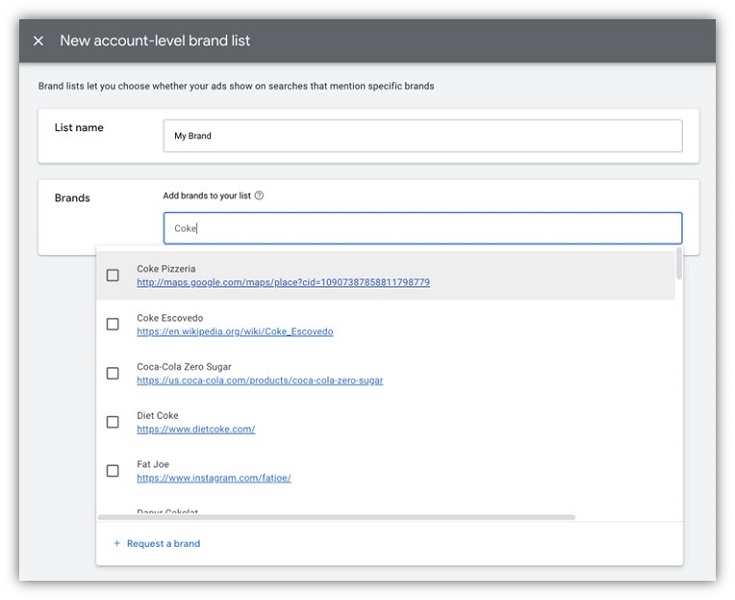

With the rollout of brand exclusion lists, advertisers can effectively stop that Brand bidding and return to non-brand prospecting through PMAX. They’re extremely easy to set up at the account level and can be customized to include sub-brands too.
4. Ability to exclude sites from Performance Max (now including search partners!)
In addition to brand keywords, Google made it possible to exclude display placements from Performance Max campaigns if you leverage account-level placement exclusion lists. This was an amazing update that made it much easier to control the performance of Performance Max campaigns.
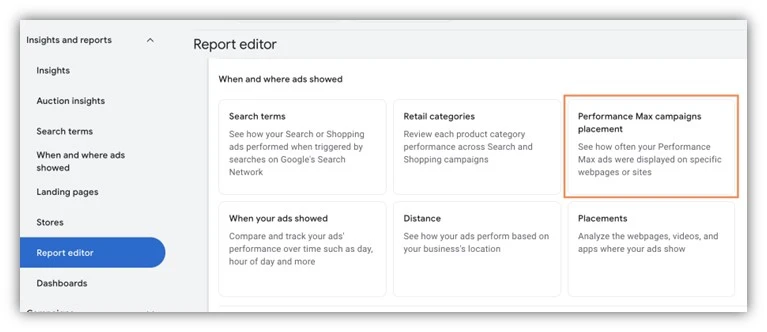

If you weren’t sure which placements you should add, Google created a report where you can see the impression counts for your campaigns on each individual site. It’s not perfect since we don’t see actual conversions, but it did provide some transparency.


In March of 2024, things just got even better. In this help article showing how to create those placement reports, Google said it will now include search partner sites alongside the display placements for Performance Max.
Additionally, when you add a search partner site as an exclusion at the account level, it will now apply to ALL campaigns in your account, Performance Max and Search campaigns alike.
At the same time, Google has removed the ability to opt out of the Search Partner Network altogether for Performance Max campaigns, a change originally meant to be temporary and address the backlash they got from an Adalytics report saying the content wasn’t suitable.
What these Google Ads Performance Max updates mean for advertisers
Despite many updates over the last three years, it’s clear to me that Google’s current focus is on transparency & control of placements and the creative assets used for Performance Max. Whether you’re just getting started and want to start with some Performance Max best practices or if you’ve been running PMAX for a while and you’re trying to stay in the know, it’s important for you to pay attention to these two trends in PMAX and make sure you’re adjusting your campaigns as needed. For more insight into how to, well, maximize your Performance Max campaign performance, see how our solutions can help!
PPC
Share Of Voice: Why Is It Important?

PPC is an industry awash with metrics, many of which are less important than others. One which you cannot afford to ignore is Share of Voice. Beyond “visibility of your campaigns compared to your competitors” what actually is Share of Voice? And why is it important?
By the end of this post, you’ll be in possession of a comprehensive conceptual understanding, plus you’ll be fully versed on how to make use of it to inform your PPC campaign decision-making.
What is Share of Voice?
Share of voice, which you might also hear referred to as SOV, is the metric used to measure the visibility of your brand compared to your competitors. Needless to say, the more market share you own, the more authority and awareness you gain among users and potential customers.
Share of Voice can be used to measure a brand’s share across different digital marketing channels, such as volume of mentions on social media, PPC, SEO, and PR.
Why Is It Important To Calculate Share Of Voice?
SOV is a powerful enough metric to help you understand where your brand stands in the grand scheme, giving you the insights you need to scale, and convert new users.
Here are three areas where SOV can change the game for your business.
1. Track User Conversations
How do you determine your product success across the different marketing channels? Using metrics, of course!
Using social media share of voice metrics to determine users’ opinions regarding certain brands and topics is a terrific idea. The metric does all the heavy lifting to help you align your product or service with the consumer’s thought process and needs.
Share of voice data can help you figure out all of those things consumers are struggling with—a unique opportunity to hit the pain points and offer real solutions.
Let’s assume that your company provides business assessment services. After calculating the SOV metric, the data tells you that many clients aren’t satisfied with your competitor’s lack of comprehensive financial analysis tools. Your best bet is to offer a strong and advanced financial analysis feature to gain that competitive advantage straight away.
2. Keeping an Eye on Your Competitors
No matter what your marketing game plan is, keeping tabs on your competition will always allow you to stay ahead of the curve. Calculating Share of Voice is one of the best ways to do this.
When you paint a clearer picture of what goes into the competitive landscape, you’ll not only have the opportunity to enhance your product, but you’ll also identify unmet needs in the market and create a solid lead generation funnel.
3. Brand Reputation Management
“What about the conversations about my personal brand?” Guess what? You can measure those too! This allows you to slice and dice your data, and see how your brand reputation stacks up against the competition.
Never underestimate the power of those brand conversations, whether they’re about product pricing, performance, new fundraising — or even a small feature update, as they can help you get that first-mover advantage, and enhance your brand reputation.
What’s the Difference Between Share of Voice and Market Share?
Share of Voice calculates brand awareness on a particular marketing channel, while market share refers to the percentage of a market that a business owns, either by income or number of clients.
These two metrics might sound very similar, and they both measure your performance compared to your competitors. Market share, however, is the percentage you get in terms of sales, while share of voice is the percentage of the conversations you earn across various marketing channels.
So imagine you’re in the smartphone industry production, and you’re launching a new model called the Spider Phone. Now, let’s say there are two major players in the market: company A (we’ll call them Techies) and company B (let’s call this Innotech).
For example, if Techies have a 40% market share, this means they hold 40 out of every 100 customers. On the flip side, if Innotech has a 50% share of voice, this signifies that half of the conversations about smartphones in a particular market are dominated by their brand.
How Do You Measure Share Of Voice?
Here is the formula to calculate your brand’s share of voice across all the marketing channels:
Share of voice = (Your brand metrics / Total market metrics) x 100
Getting it right manually will take a little more work than that, since there are variations on certain metrics. The good news is that there’s a whole bunch of tools out there that complete this process with just a few clicks.
Social Media SOV
Social media share of voice is a valuable metric to be in possession of, and it’s not hard to see why. You are actually measuring consumer conversations straight from their actual posts. This is where social media analytics tools can do their magic.
Social media analytics software will automatically identify your brand or product mentions across platforms. You can then benchmark your brand against the rest of the direct competitors.
The features are pretty advanced, giving you a ton of valuable data at your fingertips, while allowing you to conduct a comprehensive social media competitive analysis. You can play around with metrics like impressions, engagement, unique authors, and more.
PPC Share Of Voice
Your PPC share of voice tells you basically how often your ads actually get seen versus how often they could have been seen. Google AdWords helps you measure this through a feature called Impression Share. What this feature does is analyze your campaign and keyword settings to figure out just how far your ads could reach.
Find out your SOV in four simple steps:
- Log in to your Google AdWords account.
- Head over to the Campaigns tab and hit up the columns icon.
- Choose “Modify columns” and then click on “Competitive metrics.”
- Select the impression rate you want to keep an eye on.
PPC share of voice data will tell you how well the campaigns you run are performing and where you should be allocating your budget.
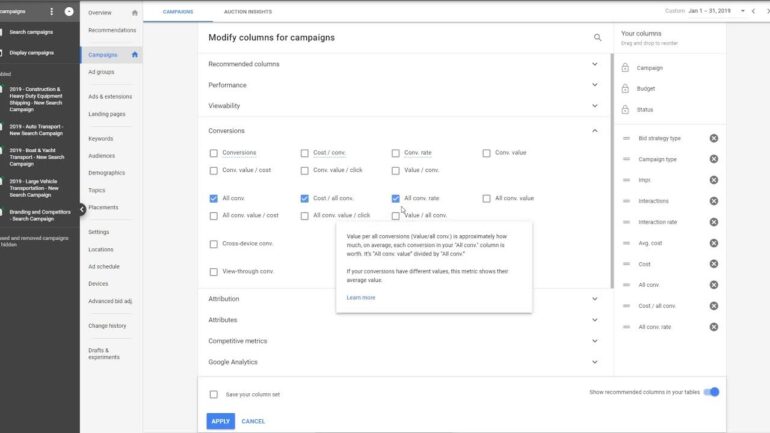
SEO Share Of Voice
When it comes to SEO share of voice, your one-stop solution is SEO tools. The in-built features found in software like Ahrefs, Semrush, and Moz allow you to effortlessly compare your brand’s visibility to your competition.

Semrush’s Position Tracking tool is the name of the game. This tool will reveal the traffic your website is getting for a targeted keyword compared to your competitors.
It’s simple to set up a Position Tracking campaign, conduct a keyword research and list out these targeted keywords. Once Semrush does its job and updates its data, you’ll see your share of voice right there on the main graph in addition to other metrics like average position, visibility, and estimated traffic.
Best of all? You can seamlessly switch between each metric to see how you compare in each one.
Amine Boussassi is a Marketing Manager for Hustler Ethos.
PPC
20 Neuromarketing Techniques & Triggers for Better-Converting Copy

You know it’s emotions, not logical reasoning, that drives decisions, right? By evoking a particular emotion in consumers, you encourage them to take a desired action.
To elicit that emotion, you need a trigger. Where do you get that trigger? By implementing certain psychological principles to your marketing message.
Expert work with all those psycho principles in content is known as neuromarketing, and you’re on the right page to learn how to make the most out of it.
Contents
What is neuromarketing?
Neuromarketing merges neuroscience, psychology, cognitive science, and marketing to understand and influence consumer behavior. It uncovers subconscious and emotional factors impacting choices.
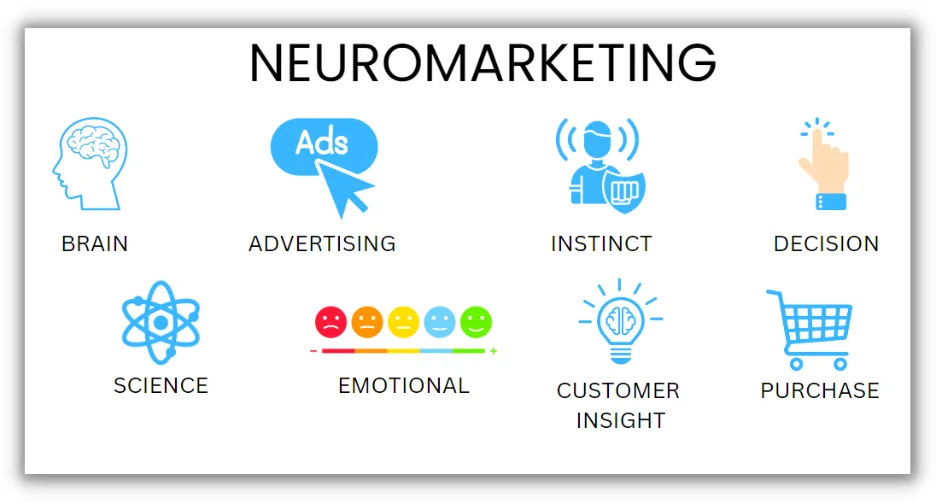
Specialists use neuromarketing techniques to study the human brain and predict decision-making behavior. While critics insist neuromarketing is outdated and manipulative, it still benefits those defending it.
🧠 Speaking of neuromarketing… Get our free guide >> 26 Brilliant Ways to Use Psychology in Your Copywriting (with Examples)
Why use neuromarketing?
Why apply neuromarketing techniques to your copywriting and other marketing activities? Here are some benefits:
- Better understanding of consumer behavior: Neuromarketing unveils emotions, attention, and memory triggers in consumer behavior, thus enabling the creation of impactful marketing messages.
- More effective ways to optimize website design: By studying eye-tracking data and user behavior, you can optimize design elements to encourage desired actions.
- Improved personalization and targeting: Uncover individual preferences and emotional triggers to tailor messages and offers for specific consumer segments.
- Enhanced content creation: Understanding how the brain processes information helps you craft compelling stories that evoke emotions and drive engagement.
Numbers speak volumes. According to the stats, neurological engagement can increase advertising effectiveness by up to 19%. We also know that 63% of users remember brands that tell stories, and 74% of consumers trust businesses more after reading positive reviews.
Neuromarketing examples in copywriting
You don’t need to be a scientist. By analyzing research insights, you can identify neurological responses, emotional triggers, and attention patterns influencing your target most. Apply them to tailor your overall marketing strategy and drive purchasing decisions.
Here are some examples of neuromarketing in action.
1. Two odd numbers in headings
The brain loves numbers: They make content more digestible and provide order to chaos.
Why two numbers? To double the effect: The first one grabs attention, and the second one explains why read the content.
Why odd numbers? It’s about psychology again: Even numbers look friendlier, while odd ones are more thought-provoking. It doesn’t mean you should use only the odd numbers. Consider the effect (emotion) you want to evoke with your content.
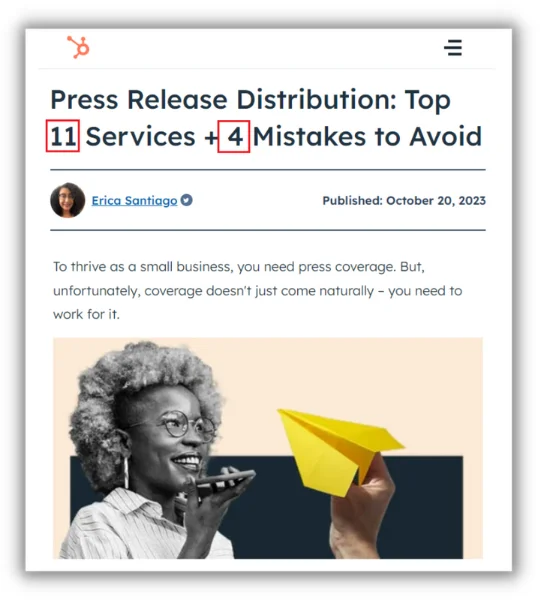

2. Questions in subheads
Online readers scan the content to understand if it’s what they need. Format subheads as questions to clarify what readers will learn, spark curiosity, and appeal to FOMO.
Questions encourage scanners to continue the investigation to ensure they haven’t missed anything and satisfy their social instinct.
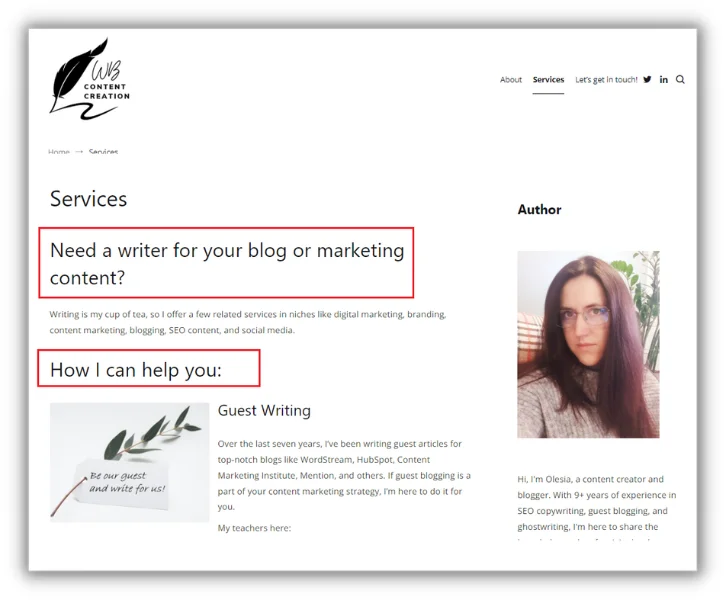

3. The Socratic method in introductions
Post three questions or statements in a row to engage users in communication.
Why three?
The human brain grasps three the best, so the sequence of three makes it easier to remember the information. Writers do love the Rule of Three: It builds the rhythm and keeps readers glued to your message.


4. Power words and active verbs in content
Power words are persuasive and descriptive. They trigger an emotional response, make readers experience different states, and push them in particular directions.
Power words are adjectives indicating and explaining your statements. Like these:
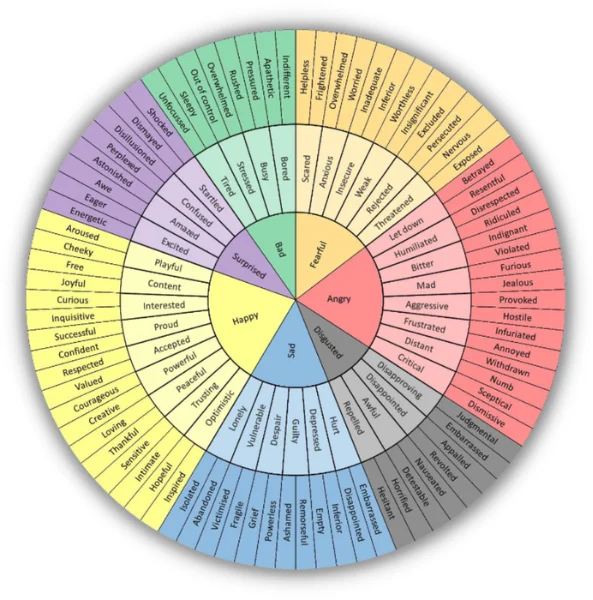

This wheel chart by Geoffrey Roberts shares 150+ emotion-triggering words you can use in your copies.
Also, power words are strong verbs that add action to your message.
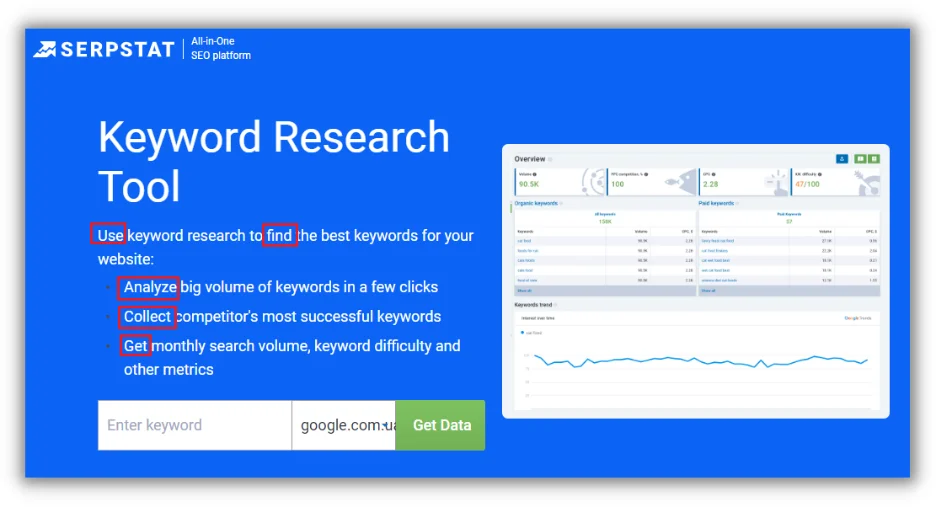

📚 Free guide download >> 135 of the Best Words & Phrases for Marketing with Emotion
5. Sensory language when appropriate
Sensory words are lexical items appealing to the human physical senses. When reading the content with such words, users “see,” “hear,” “touch,” “smell,” or “taste” it.
Sensory words are powerful because they paint scenes in readers’ imagination. They activate the somatosensory cortex, making us recognize these words faster. Sensory words make readers feel as if they are in your story, thus remembering your message better.


Remember to use these principles ethically and transparently, respecting consumer trust and expectations.
20 neuromarketing principles to encourage desired actions
With the above emotional triggers in mind, include the following neuromarketing principles in your copywriting to make it work.
1. Authority
Position your brand as an industry expert through research findings, data, and credible collaborations.
Why do you think influencer marketing works? Users subconsciously believe famous people can’t go wrong because they choose the top products/services for themselves.
But: Authority isn’t only about top celebs with millions of subscribers on social media. Think of micro- or nano-influencers: They have the most loyal audience. Collaborate with experts in your niche: CEOs, top managers, or specialists who know what they talk about.
2. Common enemy
Struggling with a common enemy unites people. It’s not only about physical enemies but pains, complexes, or bad habits, as well. Concepts like hunger, poverty, diseases, or climate change are also here.
What’s your brand’s mission? Is it socially responsible?
Users are loyal to businesses that align with their identities and share the same values. Prescribe this element and incorporate corresponding meanings into your content strategy.
Create a positive ethos for your brand: Why does it matter? Why should people listen to your message?


3. Consistency and commitment
Encourage commitment through regular communication, loyalty programs, and subscription services.
The more you interact with a customer, the more they trust your product, service, team, or individual specialist. The challenge is to establish a productive interaction and get a response.
You can initiate a dialog in messengers, newsletter emails, or online chat. Tests, quizzes, and other interactive content also work.
4. Cross-marketing
This trigger is about the intersection of several target audience segments. Organize your content so website visitors see your minor products with major ones.
In ecommerce, we know this trick as “You may also like” or “Buy together:” When examining a product description, a customer sees related items they might also want to buy.
Informative or educational websites address the same principle with content elements like “Related articles,” “Extra read,” “Editor’s Pick,” etc.


5. Framing
Different framing techniques impact perception:
- Comparative framing: Highlight superiority over competitors.
- Loss aversion framing: Use phrases like “limited time offer.”
- Goal framing: Present your product as a solution to specific goals.
- Attribute framing: Highlight appealing features.
- Time framing: Encourage immediate action by prescribing deadlines (“today only,” “first three subscribers will get…,” “two hours left,” etc.)
6. Flattery
Incorporate genuine praise or appreciation to build rapport. Personalized emails and positive feedback boost customer loyalty.
Incorporate genuine praise or appreciation to build rapport. Personalized emails and positive feedback boost customer loyalty.
You can personalize a customer by name, profession, age, social status, or hobbies. It is realistic to find a suitable appeal for every niche and customer segment.
When a subscriber, prospective client, or webpage visitor sees a familiar hook, they subconsciously realize you’re talking to them.


Their response to a personalized greeting will be faster and warmer than to generic wording.
7. Greed
Appealing to one of the core human weaknesses helps boost engagement and raise sales. Promotions, discounts, and contests encourage prospective customers to open their wallets.
Greed pushes subscribers to invite friends to groups, repost social media content, and share links. Spontaneous purchases are also here.
Palmary examples of using this neuromarketing principle: Black Friday and Cyber Monday campaigns most brands organize.
8. Herd behavior
Every person is a unique individual, and no one wants to recognize themselves as part of a so-called “herd,” but:
Social instinct is among the top three basic ones, so we can’t resist appreciation and a sense of belonging to some group. Most websites appeal to this instinct with messages like:
- “100,000+ downloads already”
- “Rating: 4.5/5 stars”
- “With over 300k subscribers and 4 million readers, we are…”
When a user sees such messages, they subconsciously approve your offer. After all, so many people can’t be wrong, huh? So, everything is okay with the product/service you have for them.
9. Intrigue
This one is like cliffhangers in a movie series, cutting off episodes at the most intriguing moment to motivate the audience to come back and watch the next one.
A few examples:
- In next week’s video, I will tell how I’ve my first 100 thousand subscribers.
- I’ve become popular by a happy accident, but I will talk about it a little later.
- I have to pause now; please wait for the second part in tomorrow’s release.
10. Justification
It is easier to push a site visitor to the desired action if you explain the why’s behind it. Reveal all the benefits of purchasing in this particular place and time.
Collect all available arguments and added values. Simplify messaging, designs, and instructions to minimize cognitive load.
11. Instant benefit
A sales funnel is a core marketing instrument, but sometimes it’s possible to get loyal clients once they land at your website. Think of a perk (a here-and-now benefit) to offer to visitors:
A free template, checklist, or ebook can become the lead magnet to hook a user to stay with you and become your client.
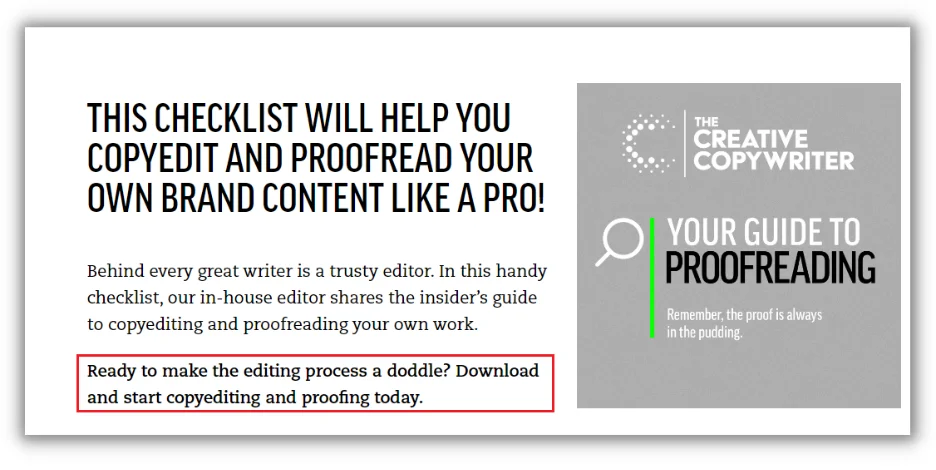

12. Novelty
Appeal to the brain’s attraction to novelty by introducing innovative elements and collaborations.
Please note that the word “new” itself doesn’t work. The trigger will do the job if your offer is truly fresh, unusual, and unique. Think of it as your UVP (unique value proposition).
What makes you different from competitors? What can you do for a customer that they don’t?
13. Reciprocity
The principle of reciprocity suggests that when you provide value to your audience, they are more likely to engage with your brand. Offer free resources, trials, discounts, or personalized recommendations.
The catch is you’ll ask something in return. For example, an email address to send informative newsletters with compelling content, encouraging to buy.
But remember: Reciprocity works when used right. It’s critical to know your limit, especially today when the audience is fed up with tons of “gifts” and offers they find in inboxes daily. Being too aggressive with marketing messages, you risk unsubscriptions and negative reactions.
Be honest and write about what you’ll send users once they share emails with you.
14. Result
The common example is content assets presenting “before” and “after” to users. Photos or videos demonstrating how your product works do the magic!
The trick is to present everything in as much detail as possible so that people can see the difference between the first and second versions.
“Before” and “after” is not the only way to demonstrate results. Case studies do wonders in all niches, too. Working with the same principle, they are the format where you can show results with a text.
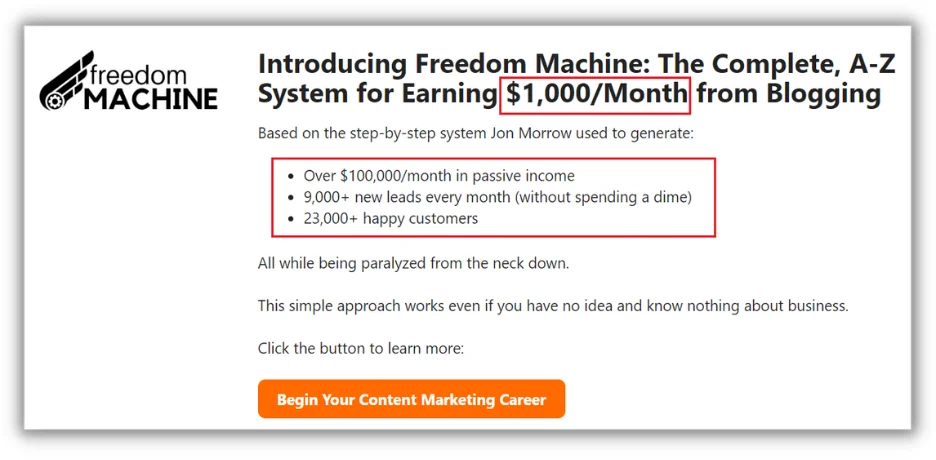

15. Scarcity
Create urgency through limited availability tactics. Ethically use limited quantity, time-limited offers, and scarcity techniques to drive action.
It’s about FOMO again: People don’t want to miss an offer that will be unavailable soon.
Two options here:
- It’s a super popular product/service of extra quality.
- It’s originally for a narrow circle of “chosen ones.”
Scarcity works with any restrictions: color, features, time, date, quantity, cost, etc. When using this trigger, it’s critical to keep your word. If sales close tomorrow, that’s what should happen.
16. Social proof
Use testimonials, endorsements, ratings, and reviews to establish trust and credibility.
Testimonials remain the most popular social proof, but it’s critical to make it trustworthy. Today’s users aren’t as naive as some marketers continue to believe: They won’t trust comments from John Doe with stock photos in avatars.
Share reviews from real people: Make videos, provide active links to their social media profiles, use signed and stamped thank-you letters from partners, etc.
Another instrument to boost social proof for users is your contact information. Many websites hide it, placing nothing but a standard contact form instead.
Wrong.
It hurts E-E-A-T factors and kills user loyalty and trust. Your address, phone number, email, and active social media accounts are worth placing on the website.
Certificates, ratings, budges–all they confirm your expertise and emphasize your responsibility and integrity in customers’ eyes.
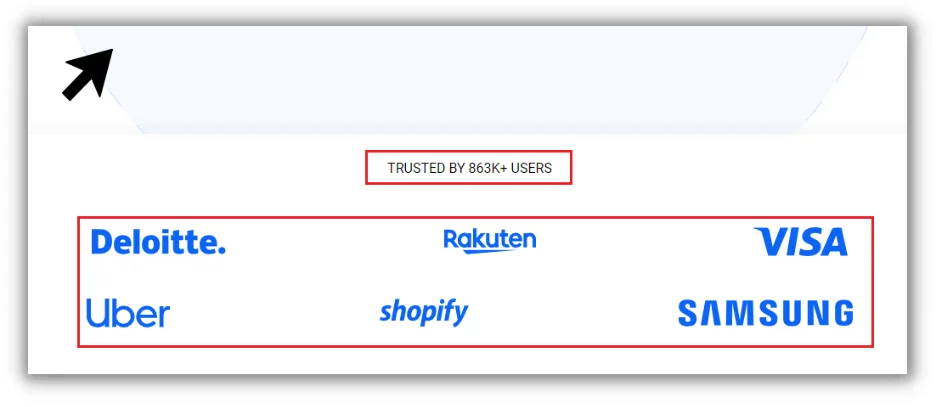

17. Specifics
It’s still an issue for many websites. They continue generating vague content assets, bringing words but no value.
Compare:
- “We sell the best windows in Chicago!”
- “Our energy-saving windows keep 93.4% of heat in your apartment.”
Yes, the example is a little hackneyed, but numbers and facts work better than sophisticated metaphors when it comes to converting traffic into leads.
Even if your niche is info products, customers want to know how long it will take to get results.
18. Storytelling
Harness storytelling’s power to evoke emotions, build connections, and make your brand memorable.
The human brain operates with stories:
- It retains 70% of information through them, while only 10% comes from data and facts.
- It responds better to narratives as they activate brain areas responsible for experiences.
- Combining data with a story increases info retention from 5-10% to 67%.
The secret is that stories don’t impose anything but, at the same time, bring the right idea to readers. Your task is to build a story in a way readers would choose your business over the others.
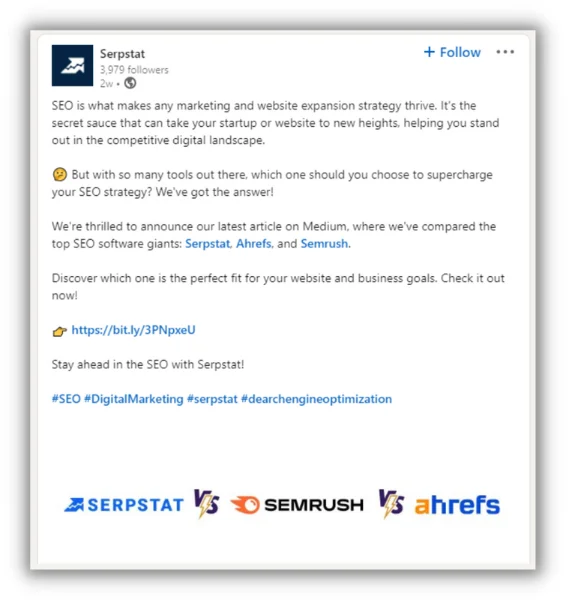

19. Upsell
This trigger serves a specific purpose: Make a customer buy more than they planned.
The oldy-moldy “Buy two–and take the third one for free” hook still works, grabbing even the savvy customers who understand the trick. Indeed, it’s hard to resist the temptation to get a free product.
20. More emotional triggers
Here are some additional emotional triggers you can use in your copywriting:
- Trust: Building credibility and reliability.
- Fear: Tapping into common anxieties or concerns.
- Belonging: The need to be part of a community or tribe.
- Curiosity: Piquing interest to learn more.
- Pride: Targeting one’s self-esteem and accomplishments.
- Guilt: Reminding the audience of a problem or responsibility.
- Urgency: Creating a sense of limited time or availability.
- Relief: Offering a solution to a problem or pain point.
- Anticipation: Building excitement for what’s to come.
- Validation: Confirming a reader’s thoughts or beliefs.
Use neuromarketing responsibly
Neuromarketing offers powerful techniques to enhance your strategies, resonating with audiences. Apply emotional triggers and psychological principles to SEO content and promo campaigns, and the result will surprise you.
But remember: Not all principles are universal, so do your best to test and iterate what works best for your audience.
Explore deeper insights, such as subconscious cues and neural engagement, to refine your strategies further.
About the author
Olesia Filipenko is a seasoned content writer who offers ghostwriting, SEO writing, and blogging services. She works with B2C businesses, providing digital marketing content that increases their search engine visibility. Check out her website WritingBreeze or her LinkedIn to learn more.
-

 WORDPRESS7 days ago
WORDPRESS7 days ago10 WordPress Influencers to Follow in 2024 – WordPress.com News
-

 MARKETING7 days ago
MARKETING7 days agoFeeling Stuck: What to Do When You Don’t Know What to Do
-

 PPC6 days ago
PPC6 days agoCompetitor Monitoring: 7 ways to keep watch on the competition
-

 PPC5 days ago
PPC5 days agoA History of Google AdWords and Google Ads: Revolutionizing Digital Advertising & Marketing Since 2000
-

 SEARCHENGINES6 days ago
SEARCHENGINES6 days agoMore Google March 2024 Core Update Ranking Volatility
-

 WORDPRESS6 days ago
WORDPRESS6 days agoThrive Architect vs Divi vs Elementor
-

 PPC6 days ago
PPC6 days ago31 Ready-to-Go Mother’s Day Messages for Social Media, Email, & More
-

 WORDPRESS5 days ago
WORDPRESS5 days agoTurkish startup ikas attracts $20M for its e-commerce platform designed for small businesses













You must be logged in to post a comment Login